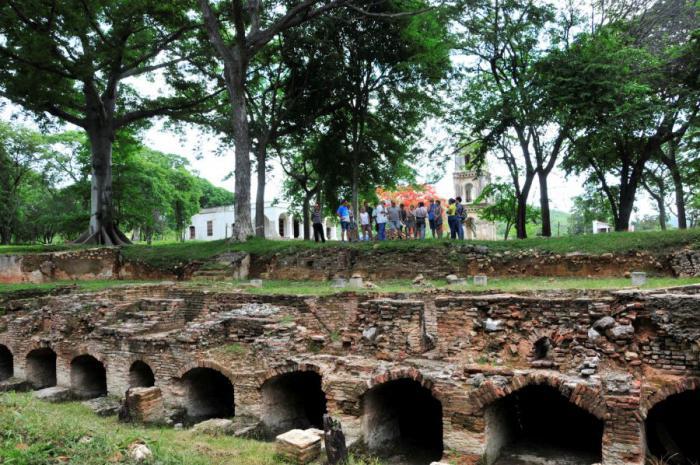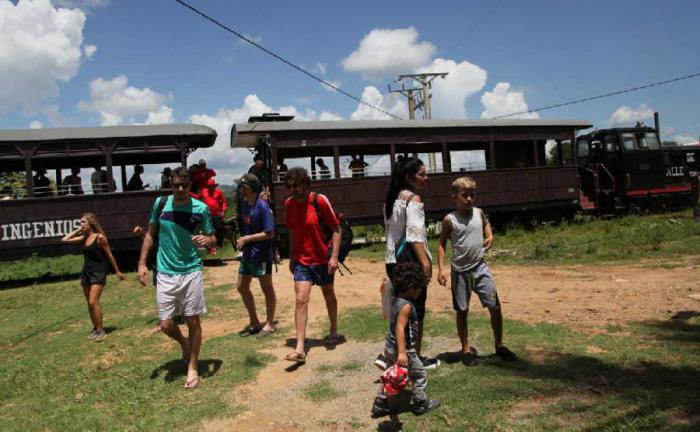
Located a few meters from the Ay river, in the outskirts of the Escambray Mountains, and at a similar distances of the railway that connects Trinidad to the rest of Cuba, the Guachinango estate boasts a unique feature: its owners always dedicated to stockbreeding, even when the zone was the main center of sugar production of Cuba and the world, and where 11,700 black slaves kept 56 sugar mills and refineries running with a production of over 7.2 thousand tonnes a year.
Guachinango passed from hand to hand without losing its ancestry and has reached our days after being the property the Padrón brothers, of influential people such as Pedro Malibrán and Justo Germán Cantero, and other equally noteworthy owners such as W.A. Fritze Co., Meyer, Thode & Co. and the Meyer-Cantero family.
The big country house of 392 meters of the Guachinango state looks like new after the exhaustive rehabilitation works of all its areas, which restored the splendor to the spacious rooms and to the entrance that protects its front, its wooden fences and its carvings in the shape a half-moon.
The works were executed by the Palmares branch in Sancti Spiritus and amounted almost three million Cuban pesos and included the repair of walls and covers, the adaptation of spaces, the plating of the floors, and the restauration of the mural paintings of the house, whose origin goes back to the early 19th century.
An ideal place for family parties, with its newly remodeled rooms, bar, kitchen and a large backyard, Guachinango is also the perfect place for horseback rides or walks, a swim in the Ay river, Cuban cuisine and the interaction with the country life at only 15 kilometers away of Trinidad, and to where visitors can go by road or by the tourist train, a two-cart, old-style engine that makes the trip across the picturesque Valle de los Ingenios (valley of the sugar mills) all more interesting.
The rescue of Guachinango is not an isolated action. It is part of an integral project that intends to turn the state houses still standing in the zone into tourist attractions that can show to the world the history of the sugar enclave which for centuries generated enough wealth to make Trinidad flourish, making it the third most important city in Cuba during the first half of the 19th century.
ONE VALLEY OR THREE VALLEYS?
Rising 43,5 meters high, distributed in seven stories all with different geometrical shapes, spacious arcs and a wooden staircase inside, the Mana Iznaga tower is not only one of the most photographed monuments in the country, but also the unmistakable symbol of the region’s economic splendor.
Whether its construction had a useful purpose or was a result of family ostentation is still unclear, but 200 years later this watchtower still impresses: in 1978 it was granted the title of national monument; ten years later, in 1988, the area it is located in –known as the valley of the sugar mills- was included, together with the historic cap of Trinidad in the list of world heritage and today it is one of the most visited places in the center of the country.
Contrary to popular belief, the name of Valle de los Ingenios is rather recent and it refers to the area composed by the valleys of San Luis, Agabama-Méyer and Santa Rosa, and the plain of the South coast, the delta of the Manatí river, a vast piece of land of 250 kilometers dedicated to the cultivation of sugar cane in the times of the colony.
The sugar industry in the area suffered the first blow with the economic crisis in the mid-19th century, followed by the impact of the war and the abolition of slavery, which impacted the prosperity of the valley, or better said, the valleys.
The last blow came at the beginning of the 21st century when, in the framework of the Alvaro Reynoso Task, the mills of the last sugar producer in the area, the FNTA refinery, previously known as Trinidad sugar mill, stopped operating.
The final death of the sugar mill industry in the region, however; open the doors to tourism, a total change of pace that forebode as much prosperity as sugar cane but with other materials now: a unique landscape right under Trinidad’s view, natural conditions for trekking and trips and 73 archaeological sites of significant value, including 13 state houses in varying degrees of preservation.
A DIFFERENT HARVEST
“The Jamaican train is neither from Jamaica nor it is a train,” a young promoter from Aldaba Company says as she shows the advanced cooking system of French origin used in San Isidro de los Destiladeros sugar mill and considered one of the best preserved industrial systems in the valley and even in Cuba.
Historian Julio Le Riverend called it the typical expression of the industrial revolution in sugar mills, this system meant a major leap compared to the systems previously used, especially because it consumed less waste cane and required less slaves working there, which was a good thing, especially in times of crisis.

Despite San Isidro not having the biggest production in the region, nor their palaces were the most ostentatious, the industrial complex the archaeologists have been digging out in the last few decades – the train, the distillery, the earthenware mill and the purge house – are major findings for the sugar mill industry of the country.
To San Isidro, whose state house and bell tower are almost intact, arrive hundreds and even thousands of tourists, many of them in national trips, interested in unearthing the sugar past of the region, and particularly it being a genuine example of the architecture and sugar engineering in the 19th century.
Harvesting without sugar, in other words, to exploit the tourism potential of the region, is basically the essential goal of the integral rehabilitation program for the Valle de los Ingenios, kickstarted in 2009 and led by the Ministry of Tourism (MINTUR) and with the participation of over a dozen organizations and which has the reconstruction of the buildings as one of their main tasks.
Eight of the state houses composed the initial part of the project, some of them are already in operation, some are in an advanced state and others are about to start: Buena Vista, Guachinango, Las Bocas, Algaba and Manaca Iznaga, operated by MINTUR; Guáimaro and San Isidro de los Destiladeros, managed by the Office of the Preserver of the City of Trinidad and the Valle de los Ingenios, and El Abanico, under management of the National Company for the Protection of the Flora and Fauna.
In order to rescue as much as possible the ancient values of these lavish houses and achieve an organic coherence with the new elements, the works are being overseen by the National Council of Culture Heritage and the Preserver’s Office, in charge of watching that the haste to make profit does not end killing the historical value of the site, which will then be the worst of sins.
Translated by ESTI















